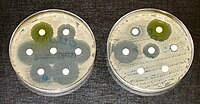
Biological and Molecular Properties of a Turnip mosaic virus (TuMV) Strain that Breaks TuMV Resistances in Brassica napus.
Sign Up to like & getrecommendations! Published in 2017 at "Plant disease"
DOI: 10.1094/pdis-08-16-1129-re
Abstract: A new resistance-breaking strain of Turnip mosaic virus (TuMV) overcomes TuMV resistance genes that currently suppress spread of this virus in Brassica napus crops in the Liverpool Plains region of eastern Australia. Isolates 12.1 and… read more here.
Keywords: resistance phenotypes; resistance; turnip mosaic; tumv ... See more keywords

Associations among Antibiotic and Phage Resistance Phenotypes in Natural and Clinical Escherichia coli Isolates
Sign Up to like & getrecommendations! Published in 2017 at "mBio"
DOI: 10.1128/mbio.01341-17
Abstract: ABSTRACT The spread of antibiotic resistance is driving interest in new approaches to control bacterial pathogens. This includes applying multiple antibiotics strategically, using bacteriophages against antibiotic-resistant bacteria, and combining both types of antibacterial agents. All… read more here.
Keywords: antibiotic phage; resistance phenotypes; resistance; antibiotic resistance ... See more keywords

Mapping trends in insecticide resistance phenotypes in African malaria vectors
Sign Up to like & getrecommendations! Published in 2020 at "PLoS Biology"
DOI: 10.1371/journal.pbio.3000633
Abstract: Mitigating the threat of insecticide resistance in African malaria vector populations requires comprehensive information about where resistance occurs, to what degree, and how this has changed over time. Estimating these trends is complicated by the… read more here.
Keywords: trends insecticide; resistance phenotypes; resistance; insecticide resistance ... See more keywords

Carbon Amendments Induce Shifts in Nutrient Use, Inhibitory, and Resistance Phenotypes Among Soilborne Streptomyces
Sign Up to like & getrecommendations! Published in 2019 at "Frontiers in Microbiology"
DOI: 10.3389/fmicb.2019.00498
Abstract: Carbon amendments are used in agriculture for increasing microbial activity and biomass in the soil. Changes in microbial community composition and function in response to carbon additions to soil have been associated with biological suppression… read more here.
Keywords: carbon; inhibitory resistance; resistance phenotypes; carbon amendments ... See more keywords